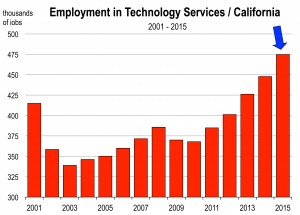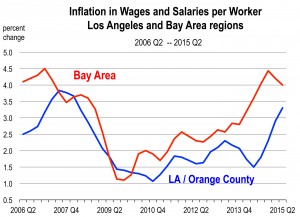By Mark Schniepp
September 2015
Approaching Full Employment
Less than two years ago the Congressional Budget Office predicted a sluggish labor market improvement in the U.S. economy with the unemployment rate making no improvement throughout calendar year 2014, forecasting an unemployment rate of 6.7 percent at year’s end.
 Los Angeles Times online, February 4, 2014
Los Angeles Times online, February 4, 2014
Well, that forecast did not work out too well for the CBO. The U.S. labor market created 2.6 million jobs in 2014 and the unemployment rate fell to 5.6 percent at year’s end.
 Now, eight months later, the economy is on pace to create 3.1 million jobs in 2015—the most since 1999—and the unemployment rate has dropped to 5.1 percent. This rate is either at or is very close to the “full employment” level of unemployment. Modern notions peg the rate at or around 5.0 percent. We haven’t seen an unemployment rate that low since April of 2008.
Now, eight months later, the economy is on pace to create 3.1 million jobs in 2015—the most since 1999—and the unemployment rate has dropped to 5.1 percent. This rate is either at or is very close to the “full employment” level of unemployment. Modern notions peg the rate at or around 5.0 percent. We haven’t seen an unemployment rate that low since April of 2008.
In California, the pace of job creation has been stellar, eclipsing previous years in the current economic cycle and pushing the rate of unemployment down to 6.2 percent. For the state as an entire economic region, we are still a ways off from the full employment rate of unemployment, but the likelihood is for that threshold to be reached by the summer of 2016.
For many counties in the state, full employment has certainly been reached. Here’s the most recent list of the counties with the lowest rates of unemployment:
| County | Unemployment Rate (%) |
|---|---|
| San Mateo | 3.6 |
| Marin | 3.7 |
| San Francisco | 3.8 |
| Santa Clara | 4.3 |
| Napa | 4.4 |
| Sonoma | 4.6 |
| Orange | 4.7 |
| San Luis Obispo | 4.7 |
| Alameda | 5.0 |
| Placer | 5.2 |
| San Diego | 5.4 | source: Labor Market Information Division |
What is Full Employment?
Typically, it’s when employers experience difficulty filling job vacancies and they have to bid up wages or salaries to keep employees from leaving, or to recruit skilled employees from other firms or right out of college.
 Nationwide, there still appears to be slack in the labor force because wages are not generally rising yet. That’s because the “underemployment rate” is still relatively high. The underemployment rate includes the unemployed plus those people working in part time positions that would prefer to work full time. The rate in August was 10.3 percent of the labor force—a big improvement over the peak value of 17.4 percent in 2009. Using this rate to ascertain reaching full employment, the country will arrive there by next summer, and wage growth is expected to accelerate in 2016.
Nationwide, there still appears to be slack in the labor force because wages are not generally rising yet. That’s because the “underemployment rate” is still relatively high. The underemployment rate includes the unemployed plus those people working in part time positions that would prefer to work full time. The rate in August was 10.3 percent of the labor force—a big improvement over the peak value of 17.4 percent in 2009. Using this rate to ascertain reaching full employment, the country will arrive there by next summer, and wage growth is expected to accelerate in 2016.
Here in California, wages are already rising in the largest labor market centers, most notably, the Bay Area. And the creation of technology jobs is the principal reason why wages are moving upward.
 Since early 2014, wage/salary appreciation rates have jumped, from approximately 2.5 percent in 2012 and 2013 to over 4 percent this year in the Bay Area. In Southern California, wage inflation moved from 1.5 percent increases per year to over 3.0 percent this year.
Since early 2014, wage/salary appreciation rates have jumped, from approximately 2.5 percent in 2012 and 2013 to over 4 percent this year in the Bay Area. In Southern California, wage inflation moved from 1.5 percent increases per year to over 3.0 percent this year.
More wage increases are coming in California, sooner than later. Labor shortages are occurring in construction, in K-12 education, in trucking and other transportation, some retail, and for skilled positions in healthcare and technology.
Higher wages will push the general inflation rate higher. Businesses will face higher costs which reduce profit levels and stock valuations. Consequently, as the expansion matures and full employment is reached, we’ll have new reasons to worry about increased volatility in the stock market, and the timing of the next recession.
__________________________________
Upcoming Autumn Conference
Santa Barbara Technology and Industry Association
Economic Summit
November 5, 2015
Radisson Hotel, Santa Maria
8:00 am – 10:00 am
The California Economic Forecast is an economic consulting firm that produces commentary and analysis on the U.S. and California economies. The firm specializes in economic forecasts and economic impact studies, and is available to make timely, compelling, informative and entertaining economic presentations to large or small groups.



